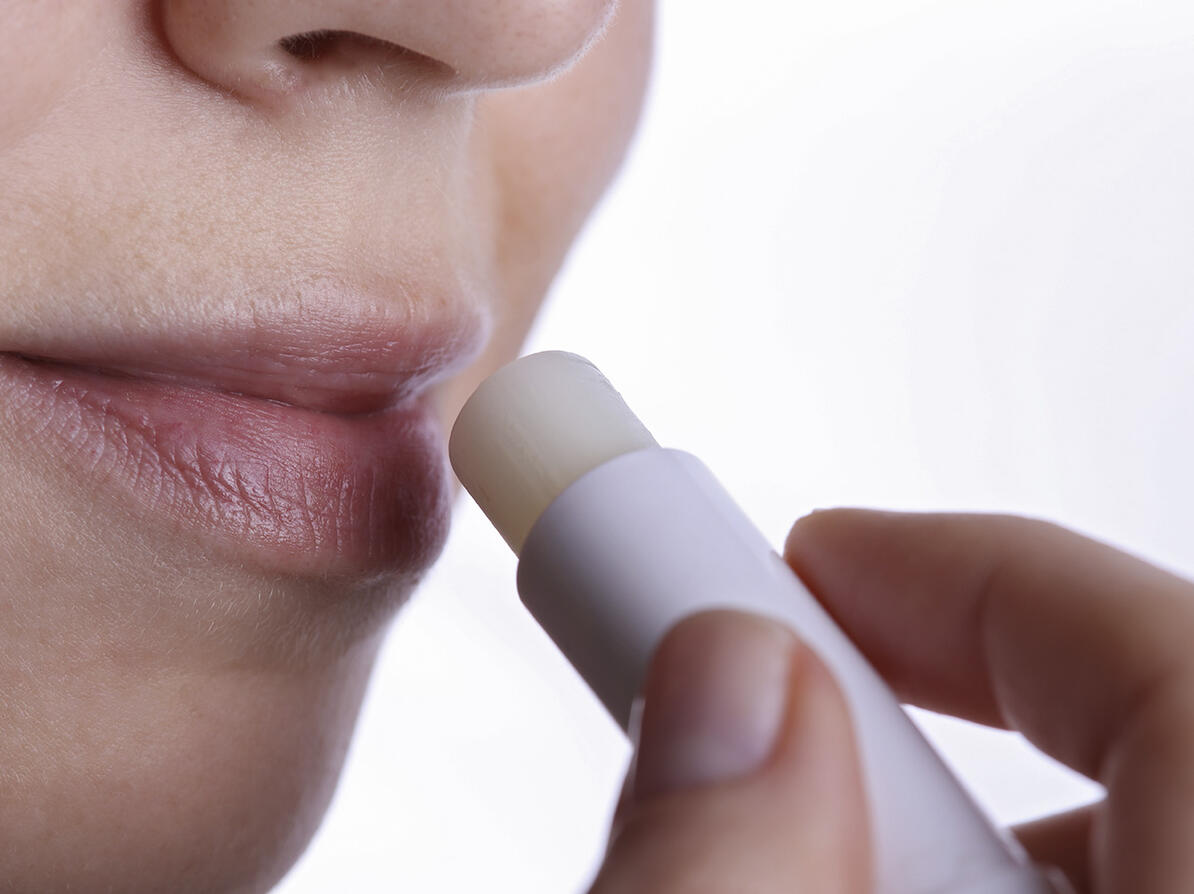Test of chemicals in lip balms
Lip balm is easy to 'eat' and thus absorbing into the body. Therefore, choose one of the lip balms in the test that is free of unwanted chemicals.

You 'eat' some of your lip balm during use
You may apply lip balm to your lips several times a day, and during use, you will inevitably ingest some of it through your mouth.
Unwanted chemicals, which for example are suspected to be endocrine disrupting, are therefore best avoided in your lip balm.
Fortunately, the test of lip balms provides several good choices.
Lip balm with A-rating is free of unwanted chemicals
You can find lip balms without unwanted chemicals by choosing one of the 19 lip balms that get the best rating in the test.
Lip balms with the A rating in the test are:
• Free of substances suspected of being endocrine disruptors
• Free of perfume that can cause allergies
• Free of mineral oils that can have unwanted effects if you "eat" them
Unwanted chemicals can be suspected of being endocrine disruptor
In the test, several lip balms contain unwanted chemicals that are suspected to be endocrine disruptors. These are, for example, the substances BHT, ethylhexyl methoxycinnamate or benzyl salicylate.
Endocrine disruptors in the individual lip balm do not in themselves pose a risk. Nevertheless, they can contribute to the so-called cocktail effect of unwanted chemicals that you are exposed to from many sources in your everyday life.
Therefore, avoid these substances whenever you can.
Avoid perfume in lip balms for children
Lip balms marketed for children may contain perfumes that may cause allergies.
Look for unscented products for children. This also applies to products other than lip balms.
Perfume does not belong in products for children.
Mineral oils can be problematic in lip balms
Several lip balms in the test contain ingredients based on mineral oils. Petrolatum and paraffin are examples of these ingredients.
Mineral oils are problematic when found in foods, because some of them can be carcinogenic and others can accumulate in the body's organs such as the liver and spleen.
You eat part of the lip balm when you use them. Lip balms with mineral oils therefore get a medium chemical rating as they contribute to your overall intake. As a precaution, you can instead choose lip balms based on natural ingredients.
The marketing of 'natural' lip balms can be misleading
Natural cosmetic brands like Ecocert, guarantee you that the natural origin of the ingredients has been required.
However, the test also shows that some manufacturers themselves claim content of natural and organic ingredients in their lip balm. This is the case, for example, for lip balms from Labello and Dr. Organic.
These lip balms contain oils extracted from plants. Nevertheless, they also contain synthetic substances that are suspected to be endocrine disruptors.
Therefore, go for lip balms in the test with the A rating. That way you get both a product without ingredients based on mineral oils and without substances that are suspected of being endocrine disruptors.
About the test
-
How we tested
In January 2021, the Danish Consumer Council THINK Chemicals purchased 51 lip balms in the Danish retail trade.
We do not know the market shares for the individual products. We have selected a wide range of products from different brands, retailers, price ranges and product types and more.
Also included in the selection are both lip balms with and without sun protection (SPF).
We have reviewed the ingredient lists for whether the lip balms contain substances that, for example, can cause allergies or are suspected of being endocrine disruptors.
We have sent product names and ingredient lists to the manufacturers to ensure that there are no errors and that the products are still on the market.
The declaration test examines the declared ingredients. The test does not take into account the concentration in the individual product.
What we found:
• 19 lip balms get the best chemical rating A. They are good choices without the content of a number of problematic substances. The products are also free of perfumes and ingredients based on mineral or synthetic oils.
• 19 lip balms get a medium chemical rating B. They are free of a number of problematic substances. However, they contain perfumes and / or plant extracts that may cause allergies and / or ingredients based on mineral or synthetic oils. In addition, the products can contain environmentally problematic substances.
• 13 lip balms get the lowest chemical rating C. They contain one or more substances that are suspected to be endocrine disruptors. In a single case, it is a perfumed product for children.
15 of the 19 lip balms with an A rating have the Swan eco-label and / or an allergy label in the form of the ‘The Blue Label’ or AllergyCertified.
Suspected endocrine disruptors
In the lip balms, we found the following substances that are suspected to be endocrine disruptors:
• Sun-filtered Benzophenone-3 - in 2 lip balms
• Sun-filtered ethylhexyl methoxycinnamate - in 4 lip balms
• Sun-filtered octocrylene - in 1 lip balm
• The antioxidant BHT - in 6 lip balms
• Salicylic acid found - in 2 lip balms
• The perfume benzyl salicylate - in 2 lip balmsLip balms with suspected endocrine disruptors do not pose a risk in themselves. However, they can contribute to an overall exposure to endocrine disruptors - the so-called cocktail effect - which is suspected of causing a number of unwanted effects.
Allergens
In one lip balm, we also found - in addition to perfume and plant extracts - content of another allergenic substance:
• the antioxidant propyl gallate, which is classified as an allergen in the EU
Perfume and plant extracts
23 of the lip balms contain perfume, aroma or plant extracts that can cause allergies.
Several of the products contain one or more of the 26 declarable perfume substances.
2 of the perfumed products are for children. The Danish Consumer Council THINK Chemicals does not recommend perfume for children, and the products receive the lowest chemical rating C.
Mineral oils in lip balms
19 lip balms contain ingredients based on mineral or synthetic oils. In 16 of the 19 products, it is ingredients based on mineral oils.
Substances based on mineral oils include:
• Petrolatum,
• paraffinum liquidum,
• paraffin,
• cera microcrystalline / microcrystalline wax,
• ceresin and
• ozokerite
• Mineral oils contain, among other things, the substance groups MOSH and MOAH.The mineral oils MOSH can accumulate in the body's organs - including the liver and spleen. The substance group MOAH can be carcinogenic.
The European Food Authority EFSA considers that the intake of mineral oils from food is of concern for health. Therefore, it is a good idea to limit the intake of mineral oils where possible.
You cannot avoid to 'eat' part of a lip balm once you have smeared it on your lips. The EU Scientific Committee estimates that with regular use you 'eat' up to 4 lip balms a year. As a precaution, you can choose lip balms without mineral oils.
Synthetic oils
3 of the lip balms contain exclusively synthetic oils.
Polyisobutylene and polyethylene are the names of some of the synthetic oils. The synthetic oils can accumulate in the organs of the body in the same way as the mineral oils.
Ingredients based on either mineral or synthetic oils trigger a medium rating B when found in lip balms.
Lip balms not based on fats from mineral or synthetic oils instead contain natural fats and oils from plants or beeswax.
-
Pierre Fabre, responsible for Avéne:
Pierre Fabre states that paraffinum liquidum is an ingredient they no longer use when formulating products.
Avène Cold Cream Lip Balm is being reformulated and is expected to be relaunched without paraffinum liquidum in late 2021.
H&M:
"All products from H&M Group are produced with great regard for customers' health and the environment.
All suppliers to H&M Group must undertake to comply with H & M's special chemical requirements. These requirements are as a minimum based on applicable laws and regulations in our sales countries as well as on other concerns about both health, environment and working environment.
All cosmetic products from H&M Group must comply with EU cosmetics legislation, and in this connection undergo a toxicological safety assessment to guarantee that they are safe to use for our customers.
As regard to cosmetic products for children, H&M Group also has the following additional requirements:
- Any potentially allergenic perfume substance must represent less than 0,001% of the final product.
Ingredients based on mineral hydrocarbons must be of food quality. In addition, they must comply with the specifications of the Cosmetic Europe Recommendation, which means, among other things, that only mineral hydrocarbons, for which is defined an acceptable daily intake, must be used.
-The products must undergo an additional toxicological assessment, where a third party toxicologist evaluates the product based on exposure scenarios other than those already examined in the toxicological safety assessment required by the EU Cosmetics Regulation.
Thus, H&M Disney Frozen Lip Balm is rated and found safe to use by children. "
-
Some lip balms contain UV filters and can provide a sun-protective effect. This typically is indicated by a sun factor, the so-called SPF, as you know it from sunscreens.
However, several UV filters are suspected to be endocrine disruptors. Therefore, some of the tested lip balms with sun protection get the worst rating of the test: C.
These two lip balms with sun filter get the best rating A:
- Apoteket's Anti-age lip balm SPF 15
- Matas Lip Balm SPF 25
